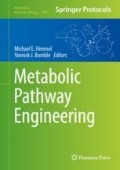Abstract
Microalgae present promising feedstocks to produce renewable fuel and chemical intermediates, in part due to high storage carbon flux capacity to triacylglycerides or storage carbohydrates upon nutrient deprivation. However, the mechanism(s) governing deprivation-mediated carbon partitioning remain to be fully elucidated, limiting targeted strain engineering strategies in algal biocatalysts. Though genomic and transcriptomic analyses offer key insights into these mechanisms, active post-transcriptional regulatory mechanisms, ubiquitous in many microalgae, necessitate proteomic and post-translational (e.g., phospho- and nitroso-proteomic) analyses to more completely evaluate algal responsiveness to nutrient deprivation. Herein, we describe methods for isolating total algal protein and conducting proteomic, phosphoproteomic, and nitrosoproteomic analyses. We focus on methods deployed for the chlorophyte, Chlorella vulgaris, a model oleaginous alga with high flux to renewable fuel and chemical precursors.
Access this chapter
Tax calculation will be finalised at checkout
Purchases are for personal use only
References
Davis R, Markham J, Kinchin C, Grundl N, Tan ECD, Humbird D (2016) Process design and economics for the production of algal biomass: algal biomass production in open pond systems and processing through dewatering for downstream conversion. NREL/TP-5100-64772, Golden, CO
Dong T, Knoshaug EP, Davis R, Laurens LML, Van Wychen S, Pienkos PT, Nagle N (2016) Combined algal processing: a novel integrated biorefinery process to produce algal biofuels and bioproducts. Algal Res 19:316–323
EERE-BETO: Bioenergy Technologies Office National Algal Biofuels Technology Review (2016) https://www.energy.gov/sites/prod/files/2016/06/f33/national_algal_biofuels_technology_review.pdf
Knoshaug EP, Mohagheghi A, Nagle NJ, Stickel JJ, Dong T, Karp EM, Kruger JS, Brandner DG, Manker LP, Rorrer NA et al (2018) Demonstration of parallel algal processing: production of renewable diesel blendstock and a high-value chemical intermediate. Green Chem 20:457
Quinn JC, Davis R (2015) The potentials and challenges of algae based biofuels: a review of the techno-economic, life cycle, and resource assessment modeling. Bioresour Technol 184:444–452
Griffiths MJ, van Hille RP, Harrison STL (2014) The effect of nitrogen limitation on lipid productivity and cell composition in Chlorella vulgaris. Appl Microbiol Biotechnol 98:2345–2356
Guarnieri MT, Laurens LML, Knoshaug EP, Chou YC, Donohoe BS, Pienkos PT (2012) Complex systems engineering: a case study for an unsequenced microalga. In: Patnaik R (ed) Engineering complex phenotypes in Industiral strains. John Wiley & Sons, Inc., Hoboken, NJ, pp 201–231
Guarnieri MT, Nag A, Smolinski SL, Darzins A, Seibert M, Pienkos PT (2011) Examination of triacylglycerol biosynthetic pathways via de novo transcriptomic and proteomic analyses in an unsequenced microalga. PLoS One 6(10):e25851
Guarnieri MT, Gerritsen AT, Henard CA, Knoshaug EP (2018) Phosphoproteome of the oleaginous green alga, Chlorella vulgaris UTEX 395, under nitrogen-replete and -deplete conditions. Front Bioeng Biotechnol 6:19
Guarnieri MT, Nag A, Yang S, Pienkos PT (2013) Proteomic analysis of Chlorella vulgaris: potential targets for enhanced lipid accumulation. J Proteome 93:245–253
Henard CA, Guarnieri MT, Knoshaug EP (2017) The Chlorella vulgaris S-nitrosoproteome under nitrogen-replete and -deplete conditions. Front Bioeng Biotechnol 17:100
Zuñiga C, Li C-T, Huelsman T, Levering J, Zielinski DC, McConnell BO, Long CP, Knoshaug EP, Guarnieri MT, Antoniewicz MR et al (2016) Genome-scale metabolic model for the green alga Chlorella vulgaris UTEX 395 accurately predicts phenotypes under autotrophic, heterotrophic, and mixotrophic growth conditions. Plant Physiol 172:589–602
Zybailov B, Mosley AL, Sardiu ME, Coleman MK, Florens L, Washburn MP (2006) Statistical analysis of membrane proteome expression changes in Saccharomyces cerevisiae. J Proteome Res 5:2339–2347
Forrester MT, Foster MW, Benhar M, Stamler JS (2009) Detection of protein S-nitrosylation with the biotin-switch technique. Free Radic Biol Med 46:119–126
R Core Team. R: A language and environment for statistical computing. R Foundation for Statistical Computing, Vienna, Austria 2017. https://www.R-project.org
Robinson MD, McCarthy DJ (2010) Smyth GK: edgeR: a bioconductor package for differential expression analysis of digital gene expression data. Bioinformatics 26:139–140
Acknowledgments
This work was authored by Alliance for Sustainable Energy, LLC, the manager and operator of the National Renewable Energy Laboratory for the U.S. Department of Energy (DOE) under Contract No. DE-AC36-08GO28308. Funding provided by U.S. Department of Energy, Office of Energy Efficiency and Renewable Energy. Additional support was received from the Laboratory Directed Research and Development (LDRD) Program at the National Renewable Energy Laboratory. The views expressed in the article do not necessarily represent the views of the DOE or the U.S. Government. The U.S. Government retains and the publisher, by accepting the article for publication, acknowledges that the U.S. Government retains a nonexclusive, paid-up, irrevocable, worldwide license to publish or reproduce the published form of this work, or allow others to do so, for U.S. Government purposes.
Author information
Authors and Affiliations
Corresponding author
Editor information
Editors and Affiliations
Rights and permissions
Copyright information
© 2020 Springer Science+Business Media, LLC, part of Springer Nature
About this protocol
Cite this protocol
Knoshaug, E.P., Gerritsen, A.T., Henard, C.A., Guarnieri, M.T. (2020). Methods for Algal Protein Isolation and Proteome Analysis. In: Himmel, M., Bomble, Y. (eds) Metabolic Pathway Engineering. Methods in Molecular Biology, vol 2096. Humana, New York, NY. https://doi.org/10.1007/978-1-0716-0195-2_5
Download citation
DOI: https://doi.org/10.1007/978-1-0716-0195-2_5
Published:
Publisher Name: Humana, New York, NY
Print ISBN: 978-1-0716-0194-5
Online ISBN: 978-1-0716-0195-2
eBook Packages: Springer Protocols

